Please Take Note: This is a review of the game’s final prototype. The art, game bits, and the rules discussed are all subject to change. The game is being reviewed on the components and the rules provided with the understanding that “what you see is not what you might get” when the game is published. If you like what you read and want to learn more, we encourage you to visit the game’s official web site and the game’s Kickstarter campaign. Now that we have all that disclaimer junk out of the way, on with the review!
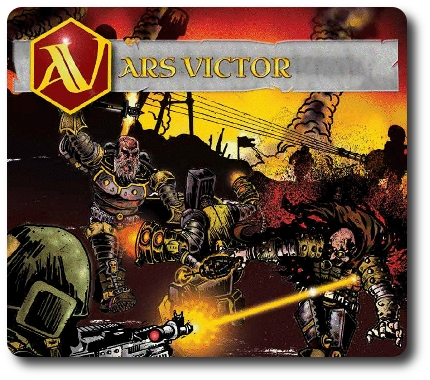
The Basics:
- For ages 8 and up
- For 2 players
- Approximately 60 minutes to complete
Geek Skills:
- Active Listening & Communication
- Counting & Math
- Logical & Critical Decision Making
- Reading
- Memorization & Pattern/Color Matching
- Strategy & Tactics
- Risk vs. Reward
- Hand/Resource Management
- Bluffing and Misdirection
- Worker Placement & Area Control
Learning Curve:
- Child – Moderate
- Adult – Easy
Theme & Narrative:
- Gather your army and destroy the enemy!
Endorsements:
- Gamer Geek approved!
- Parent Geek approved!
- Child Geek approved!
Overview
The soldiers were hunkered down behind their barricade on the outskirts of the small settlement. They had solid intel that the enemy was advancing on their position, but the distant treeline made it difficult to see the enemy approach. Then came a rumbling that sounded like thunder and the soldiers looked up into the cloudless sky. Too late, they realized that the enemy was advancing from above! Both sides fire at each from the ground and the sky, while a large cannon emerges from the treeline, unnoticed.
Ars Victor, designed by Stephen DeBaun and to be published by Trip West Games, will reportedly be comprised of 9 double-sided map tiles (with detailed terrain), an unspecified number of Capture Point tiles, 2 end caps (used to help hold the fully built map during game play), 50 double-sided Unit counters (representing 12 different types of unites), 12 customized six-sided Attack dice (in the colors red, white, and blue), 2 Headquarters (HQ) markers (one each per player), 2 Glory markers, 24 Banner tiles, 48 Command cards (24 per player), 2 full-color double-sided Quick Reference sheets (one per player), 7 Command tokens, and a moderate number of Damage counters. As this is a review of a prebublished game, we will not comment on the game component quality. However, after playing the game many times, I am most pleased to report that every game piece in the box is used and is designed very well. If I wasn’t told by the designer that I was being given an early prototype review copy, I would have easily believed I was given the final game. Not included in the game, but helpful to have, is a pen or pencil and some paper for each of the players to use during game set up to help keep track of some very easy math.
Mustering Your Troops
To set up the game, first determine which color (red or blue) will represent each player’s army. Give to each player the 12 Banner tiles, 24 Command cards, 1 Glory marker, and 1 HQ marker in the player’s selected color.
Second, each player now builds their own army using points. Each player will have a budgeted amount to spend. Normally, each player will have 80 points to spend on their army. The catch is that each time they spend their points to increase their army’s overall numbers, they reduce the number of points needed for their opponent to win the game. Therefore, a player is free to build whatever army they like, but at the cost of risking an early demise at the gaming table if they are not up to the task of beating their opponent. Players can never spend more than their total budget and are highly encouraged to spend intelligently. Note that all the information the player needs to quickly review a unit is printed on the Unit counters. Further details for each unit are available on the Quick Reference sheets, too. Players should feel free to use the pen or pencil and a piece of paper to help keep track of their total budget and what they have spent to build their army. Additionally, all drafting of armies and selection of units should be done secretly. No divider or player screen is provided with the game at this time.
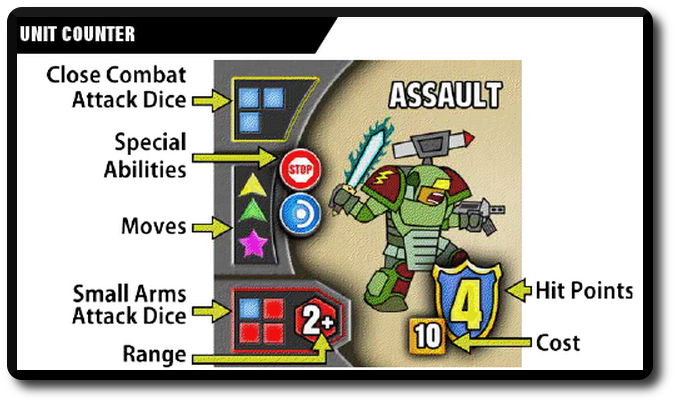
Third, each player now selects one of the units they purchased and attaches the HQ marker to it. The HQ marker doesn’t enhance the unit, but it does make them a huge target.
Fourth, each player now reveals their units selected and places them next to the edge of the game board. These units represent the player’s “Reserves”. Each player takes their Glory marker and places it on the numbered track located on one of the two end caps. The player’s starting Glory value is equal to 80 minus the total number of points they spent building their army. For example, if they build an army worth 60 points, the player would have a starting value of 20 Glory points. One of the two end caps contains a point track to keep note of each player’s total Glory points during the game.
Fifth, both players now build the battlefield. This is referred to as “Scouting”. All 9 of the map tiles are shuffled and placed in a stack to one side of the playing area. Starting with the player who selected the blue colored Command card deck, each player will take turns drawing a random map tile, determine which side they want to use, and then place it on the table. The rule book provides a detailed description on what a properly formed map will look like. Players can also add in one or more Capture Point tiles to the map if they so choose. The rules suggest that at least one be added to the center of each of the map tiles in the battlefield. Once the map tiles are in place, slide the end caps into place.
Sixth, players now shuffle their individual decks (feel free to allow each player to cut their opponent’s deck) and draw 5 cards. This is the player’s starting hand and should be kept hidden from their opponent at all times.
Seventh, starting with the player who selected the red colored Command card deck, each player will place 4 of their units on the battlefield. These initial units are referred to as the player’s “Vanguard”. Each player’s Vanguard can be placed anywhere in a single space in one of the two hex rows closest to them. Only one unit can ever occupy a hex space at a time. A player is not required to play their HQ to the battlefield as part of their Vanguard. When placing a unit (be it part of the Vanguard or brought out later in the game), a Banner tile is placed underneath it. Each Banner tile will represent a certain Command card color (red or black) and a card suit (spaces, clubs, hearts, and diamonds). These are used in conjunction with the Command cards in the game.
Seventh, place the dice, counters, and remaining tiles to the side of the game playing area and within easy reach when needed. When completed, your game set up might look something like the following.
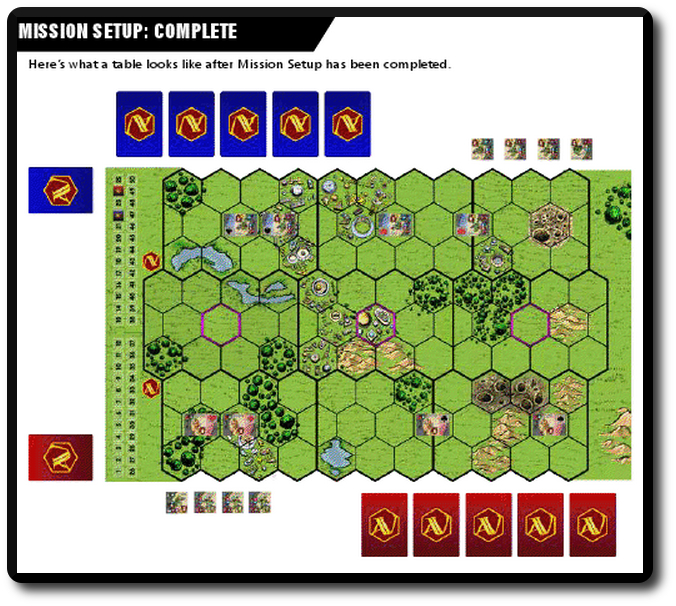
That’s it for game set up. Time to charge and see which army will prevail!
The Dogs of War
Note: Ars Victor is not that complicated of a game, but the level of detail included in the rule book would suggest otherwise. We are only going to summarize the game play here and encourage you to review the rule book for further details.
The game is played in turns for a total number of no more than 24 rounds, although many games will end well before that. Each player will take alternating turns completing a simply and straightforward sequence of play that is summarized here.
Step 1: Score Glory Points
During this step, the player does a quick inspection of the game board and reduces their opponent’s Glory points for having control of specific locations on the battlefield. If the unit that currently controls the Capture Point is also the player’s HQ, they score 1 additional Glory point. The player also scores 1 Glory point if they are the only one of the two players to have their HQ on the battlefield.
Step 2: Play Command Card
The player’s Command cards are what drive the combat in the game. Each Command card will contain a number, a color (black or red), a card suit (diamond, clubs, spades, or hearts), and a certain number of Command token icons. Any number of units can be moved during a player’s turn as long as the player has enough Command tokens to spend and the units being moved either match the color of the card being played or are the exact same suit. Once the card is played, the player collects the number of Command tokens noted on the card and places the Command card in the discard pile.
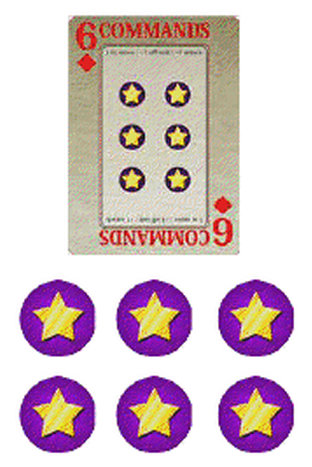
Step 3: Order Units
During this step, the player is going to spend the Command tokens that were provided by the Command card they just played. A player can issue one of two different orders to as many of their units as they like as long as the unit is matching the suit or color of the Command card that was played.
- Advance: this order costs 1 Command token (2 if the unit is off- suit, but on-color) and allows the unit to walk and run. Refer back to the unit image above and you’ll see two arrows. One is green and one is yellow. The green arrow represents how many hex spaces the unit can walk (if two were shown, then the unit could move 2 hex spaces). The yellow arrow represents how many spaces the unit moves when running.
- Assault: this order costs 2 Command tokens (3 if the unit is off- suit, but on-color) and allows the unit to only walk and then attack.
Note that units that are engaged (adjacent to any hex space that contains an enemy unit) cannot walk or run. Reserves can be brought out onto the battlefield via an Advance order. When brought out, the player decides on the banner color and suit that will be attached to it. Players need to keep track of the cards they played or they risk assigning a unit a color or suit that is almost exhausted!
When moving terrain does impact movement. Open hex spaces on the game board do not obstruct ground movement. Everything else does and is considered “slow terrain”. Slow terrain stops movement immediately when a unit enters it, no matter how many more hex spaces the unit could move if not obstructed.
When engaging in combat, the unit will use different dice depending on how they are attacking. There are three forms of combat and not every unit can engage their opponent using all three. Close combat, small arms fire (ranged combat), and heavy weapons are all utilized on the battlefield and have different odds of damaging their target. The blue Attack dice are the most damaging, followed by the red Attack dice, and the weakest are the white Attack dice. When using a ranged attack against a unit that is currently within slow terrain, the target gets a bonus to their defense by reducing the odds of the weapons being fired upon them doing damage. Some terrain even stops an aggressor from using ranged weapons of any type, forcing everyone to get “close and personal”. And when they are done being attacked (and are still standing), the target might have a chance to counter-attack with a quick volley of hot lead.
All damage is tracked on each individual unit. When the unit takes a number of hits equal to or higher than their Hit Point value, they are removed from the game board. The owning player then reduces their total Glory points by the number the unit was worth!
But the units in Ars Victor are much more than gun-toting hooligans (well, not all of them). Units have abilities that give them freedom to travel through slow terrain and even through the sky. Some of the units are marksmen and some can even drop from high above to a specific point on the battlefield to assist in an assault. The Quick Reference sheet provided to each player lists all the unit abilities.
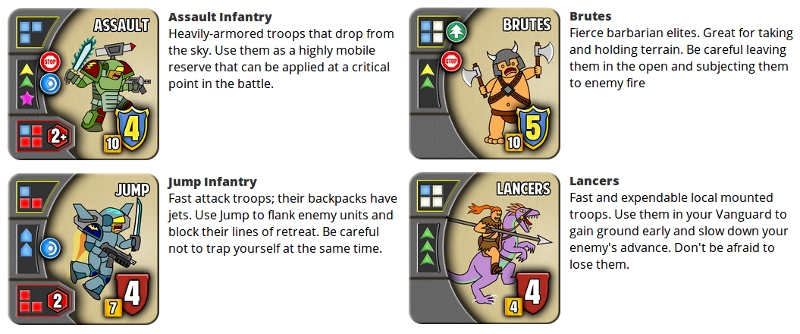
Once the player has finished issuing orders to each of their units that they can pay for using the Command tokens, this step is completed. Note that a player is not required and sometimes cannot use all the tokens.
Step 4: Draw a Card
During this final step, the player draws a card from their deck to bring their hand size total to 5 cards. It is now their opponent’s turn.
Victorious Victory!
The game can end several different ways, but there will always only be one victor.
- The game ends when one of the two players has zero or less Glory points
- When one player has no more units left to play
- When only one player has a unit that is designated as the HQ
- When both players run out of cards (in which case, the player with more Glory points wins)
Game Variants
There are several game variants worth mentioning for Ars Victor, and I am sure we will see many more when the game is finally published.
- Missions and Predefined Unit Rosters: the standard game allows for the players to build their own units and create their own battlefield. These games are fun, but the only objective is to simply survive. Additionally, a less experienced player will quickly find they are outgunned by a more experienced player’s choice of combat units. The game comes with a number of missions (predefined game board set up and objective points) and unit rosters that can be used at the player’s pleasure. This keeps everything balanced and makes it easy to set up and play the game.
- Junior Victor: the standard rules of play are very straightforward, but game play can become very complicated with many different choices to make, cards to manage, and units to control. A stripped down and simplified rules set, Junior Victor, is available that serves as a great way to not only introduce the game to new players, but also reduces the complexity enough to make Ars Victor a game Child Geeks can play without getting a nose bleed. The use of the Command cards is simplified, all units see a bump in movement, and combat is the same except that none of the unit abilities are used. Games using the Junior Victor rules are much faster and simpler, but a player must still command with intelligence.
To learn more about Ars Victor, read the full rules, download a print-n-play copy, or grab a Vassal module, visit the game’s official web site and the game’s Kickstarter campaign.
Prediction
My groups have been playing a lot of wargames as of late. So many, in fact, that I think they are just about burnt out on gunning, running, and ducking during their game play sessions. But they are not yet so far gone as to not continue to meet me at the table and try a new game or two. Thankfully, Ars Victor has visual appeal and it wasn’t hard to get players to join me.
After reading the rules, I was left with a strange feeling of nostalgia. I can’t put my finger on it, but there is something about Ars Victor that reminds me of the first wargames I played as a teenager. In truth, Ars Victor is not doing anything new in regards to game play and game mechanisms, but the entire game is none the less very appealing and strangely familiar. For example, the use of Command cards reminds me a great deal of Memoir ’44.
I think Ars Victor will do very well with the Parent Geeks who are interested in wargame and their Child Geeks who are interested with them. The Junior Victor rules are not so stripped down so as to make the entire game playing experience a dull one, which should appeal to the Parent Geeks who are teaching the game to their Child Geeks and it might be just enough to get a few of the non-gamer Parent Geeks interested, too. I don’t think the Gamer Geeks are going to have any problems with Ars Victor, unless I have a chance to play the game with some truly hardcore wargamers. The “pure blood wargamers”, as I like to call them, can be exceedingly critical about any game that even remotely suggests it is a “wargame”. We’ll have to see who is available.
Teaching Ars Victor will take some time, but no more than about 15 minutes of game rules and explanation. I highly suggest you use the Junior Victor rules for Child Geeks and anyone who is not familiar with wargames. There is a lot to consider and mentally digest if you play the standard game. Luckily, the Junior Victor rule set is light enough to be easily taught and flexible enough for the teacher to tweak it to introduce the more complex game rules without upsetting game balance. This is what we did for our groups and tailored each of the gaming experiences according to the player’s level of gaming skill and wargaming familiarity.
Do expect a number of questions regarding the Command cards and the unit abilities. These were two of the most popular questions we received while teaching the game. I also suggest you make it VERY CLEAR to the players that the Command cards, like their units and Glory points, are limited in number. Players must look at each of their cards as a finite resource. Once they are spent, they are gone.
For my oldest little geek, who at this point is almost completely fried and borderline passive aggressive towards wargames, is something of an unwilling participant for this review. He has a lot going on at school and I’ve been sitting down every night to play the same game a number of times. with him. He is getting tired of it, but he is ready to play the game at least once. After teaching him the rules, he was set to play. As he and I shuffled our Command card decks, I asked him his thoughts on Ars Victor so far.
“It looks fine, doesn’t sound all that complicated, and I like a lot of the abilities. Should be a fun game, but let’s not play anymore wargames for a while after this, please.” ~ Liam (age 8)
Looks like this might be the last wargame I play for a bit with my oldest little geek. Let’s see if the time and energy he is graciously offering is well spent.
Final Word
The Child Geeks were mixed at first. When we first started playing Ars Victor we did not have access to the Junior Victor rules. Many of our older Child Geeks were enjoying Ars Victor “as is”, and showing no difficulties whatsoever when it came to understanding the rules and the game play. They were making solid strategic decisions and demonstrated some very interesting (and ballsy) tactics. The younger Child Geeks were suffering through it, however, and were getting tripped up by the game’s subtle details. After we introduced the Junior Victor rules, however, all that changed. The younger Child Geeks excelled at the game using the slimmer rule set and some of the older Child Geeks even preferred the simpler game play. When we had finally played the game enough times using both rules, we couldn’t find one Child Geek who didn’t enjoy themselves. Ars Victor was approved by the Child Geeks, and to quote my son and his advice to another of his friends, “Start with the simple rules, first. It’ll make you a better general.”
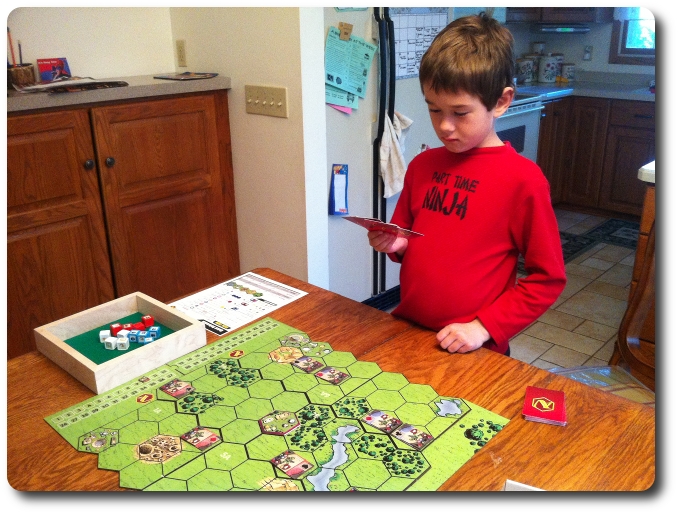
My little geek general carefully considers his move as he overlooks the battlefield….
The Parent Geeks were also mixed at first and showed the same level of frustration and enthusiasm as their younger mini me’s. Again, we introduced the Junior Victor rules and everything fell into place. I cannot stress enough that Ars Victor is NOT a terribly difficult game, but it does require the player to think and keep track of a lot of things. The game can be downright stressful at times as the player is suddenly confronted with multiple choices that all seem to be difficult to successfully pull off. When we reintroduced the Junior Victor rules to the Parent Geeks and non-gamers who said Ars Victor wasn’t for them, 2 out of 3 individuals changed their mind about the game and really started to enjoy themselves. The learning curve for the standard game is not hard, but by reducing how much a player had to think about without reducing the level of tactics and strategy, the players were able to focus more on the joy and challenge of the game instead of constantly fumbling through all their choices. The Parent Geeks voted to approve Ars Victor.
The Gamer Geeks wanted nothing to do with the Junior Victor rules and saw Ars Victor as (and I’m quoting here), “a great and quick wargame that gives you all the punches in the face you need in a fraction of the time you’d expect.” Not sure how that translates to “good”, but the Gamer Geeks really enjoyed themselves with Ars Victor. So much, in fact, I had a hard time gathering everything they said. I boiled it down to their top 3. Specifically, “lots of strategy”, “lots of tactics”, and “lots of player control”. According to one Gamer Geek, “this is a great game – the rules are tight, the game play is solid, and there is a lot of depth to the game to explore.” All the Gamer Geeks happily approved of Ars Victor.

Gamer Geek Karl Gamer Geek rages
I am exceedingly pleased with Ars Victor. It’s fast to set up, a lot of fun to play, and can be exceedingly nail-biting at times. During one game with a fellow Gamer Geek, it all came down to a roll of the die before we both lost because our Command decks were almost exhausted. Another time, my opponent and I kept going at each other with guerrilla tactics until one of us positioned a heavy gun and left a crater where the last of the remaining enemy units once stood. But the best experience I had was when my 8-year-old successfully flanked me with a few jump units, trapping my HQ which gained him a victory.
Here is a game that provides a lot of depth of play, complete freedom to strategize, and more tactics than you can throw a grenade at. But best of all, Ars Victor is a game that can be played by anyone. We taught it to non-gamers who picked it up and were playing very well after just a few rounds. From Child Geeks to Gamer Geeks (and everyone in between), Ars Victor was well received and greatly enjoyed. Thanks to the rules, Ars Victor is a game that can grow with the player, making it a great “gateway” wargame and a casual but deep challenge for the more seasoned wargaming veteran. Do look into Ars Victor and see if it’s the right game for you.
This game was given to Father Geek as a review copy. Father Geek was not paid, bribed, wined, dined, or threatened in vain hopes of influencing this review. Such is the statuesque and legendary integrity of Father Geek.



